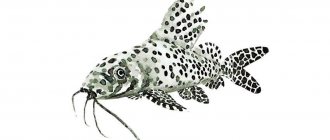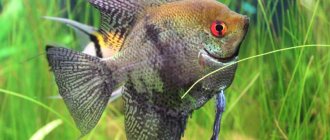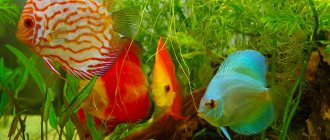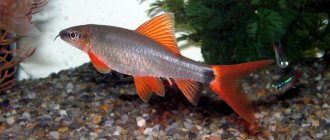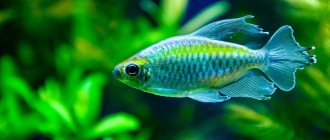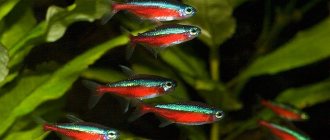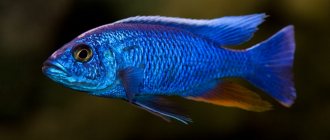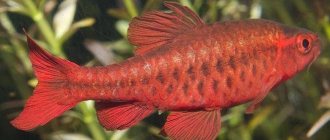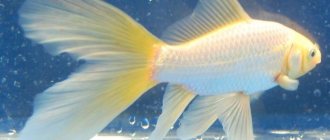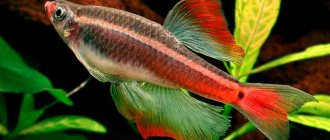Description
The Indian glass catfish is a species of fish from the family Siluridae. The original name of the species is kryptopterus minor. Translated from Greek, it means “invisible” and “fin”. The name simultaneously indicates the transparent color of the body and the absence of a dorsal fin.
Ghost catfish are found in their natural habitat in southeast Asia. The number of individuals in the population increases in the overgrown rivers of Thailand, Indonesia, Java, and Sumatra. They prefer rivers with muddy and stagnant water or with minimal flow.
It is not recommended for beginners to purchase; This species has medium difficulty of keeping.
Appearance
The ghost catfish is notable for its appearance. The peculiarity is noticeable at first glance - the almost complete absence of body coloring.
The skin, muscles and scales are colorless and appear transparent, which is why the species got its name. The spine, swim bladder, internal organs and head of the species remain painted. Due to the transparency of catfish, their bodies allow sunlight to pass through, which allows them to be inconspicuous in their natural environment.
The body is long and flattened in the lateral parts. The adult size is 5–12 cm. The anal fin is longer than that of most fish and extends from the head to the tail. And the dorsal fin is completely absent. The caudal fin is transparent, small in size and forked. The head is small, outwardly shaped like a triangle with smoothed edges. There is one pair of long antennae on the head.
Behavior
Aquarium glass catfish have a timid and skittish temperament. At the slightest sharp and loud sounds, individuals hide in shelters. This species is not inherently aggressive - these are peaceful fish and they get along calmly with other species if they do not show hostility or start fights.
Glass catfish - Indian ghost
Glass catfish - Indian ghost!
Lat. name: Kryptopterus bicirrhis.
Water parameters for keeping:
Size in aquarium: 10 cm.
Life expectancy is up to 10 years.
The glass catfish lives in Southeast Asia, the Greater Sunda Islands, Java, Sumatra and Borneo. They were first brought to Europe in 1934, to the USSR in 1964. When this fish was first introduced to Europe, its lifestyle and, above all, its method of reproduction remained a mystery. Based on observations of fish behavior in nature, experts say that during the rainy season, adult fish migrate to the surrounding jungle where they spawn. And as soon as the water begins to subside, they return to their original places along with the young fish. To this day, glass catfish are not bred in aquarium conditions. In the markets we see either wild animals or fish from Asian farms.
The Indian glass catfish belongs to the group of ghost fish, with which all “glass fish” (English name Glass Catfish) are identified because of their protective coloring, which makes the fish hardly noticeable in the water. In addition to transparency, the glass catfish is distinguished by a body that is highly elongated and laterally flattened. The dorsal fin is extremely small and is located immediately behind the head; from below the head, almost to the deeply cut caudal fin, a constantly oscillating, completely transparent anal fin stretches. In reflected light, fish shine with all the colors of the rainbow, while at the same time remaining so transparent that objects behind the fish can be seen through them.
The following catfish also have a similar lifestyle: Kryptopterus macrocephalus, Ompok bimaculatus and Silurichthys phaisoma. They always stay in a school, in the middle layers of water and are diurnal fish. Lonely fish outside the school wither and die. Therefore, glass catfish must be kept in a school, in spacious aquariums, in which there are many plants that provide the fish with shelter and diffused lighting.
To keep a flock of glass catfish (5-7 individuals), an aquarium of 150 liters or more is recommended; aeration and filtration must be installed in the aquarium. Weekly changes of aquarium water are required. Other measures are being taken to reduce nitrogen compounds - NH4, NO2, NO3. Fish cannot tolerate them. Glass catfish can be kept in a wide range of water parameters, but the most comfortable will be soft, slightly acidic water, which is characteristic of their habitat.
We combine glass Indian catfish with virtually all peaceful small fish - gourami, armored and loricariid catfish, various characin fish, etc.
In nature, the favorite food is zooplankton and larvae of aquatic insects. The fish clumsily picks up food from the bottom, lying on its side. In aquarium conditions they eat all types of food very well. Please note that feeding aquarium fish must be correct: balanced and varied. This fundamental rule is the key to successful keeping of any species of fish. Therefore, it will be useful for you to read the article “ How and how much to feed aquarium fish ,” which describes this in detail, and also outlines the basic principles of the diet and feeding regime for fish.
At this time, dry food is, of course, popular and popular food for fish. For example, all the time and everywhere you can find food on aquarium counters - the leader of the Russian market, which has an assortment of food “for every taste.” Tetra’s “gastronomic arsenal” includes individual food for a specific type of fish: guppies, goldfish, cichlids, loricariids, labyrinths, arowanas, discus fish, etc. Tetra has also developed specialized foods, for example, to enhance color, fortified, or for feeding fry. You can find out detailed information about all Tetra feeds on the company’s official website - here .
It would not be amiss to note that when purchasing any dry food, you should first of all pay attention to the date of its manufacture and shelf life, try not to buy food in bulk, and also store the food in a closed state - this will help to avoid the development of pathogenic flora in it .
All of the above is just the fruit of observing this type of aquarium fish and collecting various information from owners and breeders. We would like to share with visitors not only information, but also live emotions that allow us to understand the world of aquariums more fully and subtly. Register at https://fanfishka.ru/forum/ , participate in discussions on the forum, create profile topics where you will talk about your pets in the first person and first-hand, describe their habits, behavioral features and content, and share with us your successes and joys, share your experiences and learn from the experiences of others. We are interested in every bit of your experience, every second of your joy, every awareness of a mistake, which makes it possible for your comrades to avoid the same mistake. The more of us there are, the more pure and transparent drops of goodness there are in the life and everyday life of our seven billion society.
Content
Keeping glass catfish alone develops a stressful state, which often leads to the death of pets. It is recommended to keep them in a flock of 8–10 individuals. Then the ghost catfish will feel better and calmer.
Aquarium
For a flock of glass specimens, you need a spacious aquarium with a volume of 100–120 liters. At the bottom there are shelters and decorative elements: driftwood, grottoes, embankments. The aquarium must be equipped with a reliable lid, because these transparent representatives easily jump out of the tank and end up on the floor.
Water parameters
The water temperature at different times of the year is 20–25 degrees, and it should be the same in the aquarium. "Glass" prefer soft water, the hardness of which does not exceed 10 dH. Acidity is not too important for ghosts, but should be between 4.5 and 7 pH.
Plants
In a ghost aquarium, a significant portion is dedicated to vegetation. Dense plants with wide leaves work well - they create shade and provide shelter from others.
Suitable plants:
- Cryptocoryne.
- Anubias.
- Alternantera Reineck.
- The anther is large.
- Aponogeton is viviparous.
Priming
Almost any soil is suitable - coarse sand, crushed pebbles, special soil mixtures and others. The main thing is that the soil particles do not have sharp corners, on which the catfish will injure their muzzle or sensitive whiskers.
View this post on Instagram
#kryptopterus #bicirrhis #glasscatfish #beautiful #swim #aquaria #fish #water #glass #fishporn #swimming #pescado #tagsforlikes #aquarium #acuario #liquid #watertank #coral #instagood #tropical #instafish #catfish #freshwater #tropicalfish #fishtank #photooftheday
A post shared by Can Paçacı (@canpacaci) on Mar 2, 2015 at 10:54am PST
Equipment
The aquarium will need aerating and filtering devices. The compressor is suitable for medium power, and the filter should be weak - ghosts do not like strong currents.
Lighting
Lighting should be similar to natural conditions. Catfish do not like bright light; they prefer diffused lighting. The aquarium must have darkened areas in which pets can hide.
Pimelodaceae
In nature, they live in rivers with fast currents. In captivity, with the help of aeration and filtration, it is necessary to create a flow of water. They are demanding about the quality of water, but cannot tolerate replacing a large volume of it. Like any fish that lives on the current and does not have a suction cup, it is active and mobile.
In captivity, they get used to any food, live ice cream, including tablets. Requires a large amount of shelter. If there are not enough of them, serious conflicts are possible. Fish of their own size are treated with loyalty, but fry and small inhabitants of the aquarium are treated as food. If transplanted carelessly, the sharp spines of the dorsal fins can injure a person’s hands.
Feeding
They are not too picky about food: they eat dry and granulated food well, and will not refuse live food. Due to the small size of the mouth, food particles must be small in size.
Food particles should sink slowly so that pets have the opportunity to eat in the middle layer of water. Glass catfish will not find food at the bottom. If the food does not sink, but remains on the surface, then the fish are also reluctant to eat it.
When feeding live food, catfish owners give preference to bloodworms and daphnia.
Catfish eat slowly, so make sure that other residents do not take their food.
They should be fed in small portions infrequently, about 1–2 times a day, mainly in the dark.
Selecting a heater and thermometer
In order not to lose the inhabitants of the underwater world too often, the aquarium is equipped with the necessary sensors and devices. A water heater is one of the essential items for fish. Most aquarium inhabitants are heat-loving, so they react negatively to a sharp drop in temperature. No matter how warm the room is in winter, the water in the aquarium will still not be warm enough.
The readings of the thermometer can be influenced by lighting lamps, so the thermometer is placed in the middle layers, on the wall opposite the heater. Thermometers that have a weighted tip and are placed vertically in the water are considered convenient. If the aquarium is large, measuring the water with a floating thermometer will be problematic. The water at the bottom is always colder than at the surface.
The choice of thermometers for an aquarium is very large, but each thermometer has certain disadvantages:
- Mercury temperature meters are highly accurate, but their use in an aquarium can result in tragedy. If the mercury tube accidentally breaks, the inhabitants of the aquarium cannot be saved. In addition, you will have to throw away all vegetation and decorations.
- Electronic instruments are the best choice when assessing the quality of measurements. The error of such devices is minimal, but the price is unreasonably high, so not everyone can afford an electronic thermometer for an aquarium. Some electronic temperature meters are equipped with sensors that sound an alarm if the temperature in the aquarium has dropped or risen to critical levels.
- Liquid crystal thermometers are glued to the outside of the aquarium. These meters are represented by a strip on which a color scale is applied. It is impossible to say that these devices are accurate, but they are in demand among consumers because they are easy to maintain. It should be noted that the thicker the glass of the vessel, the greater the error of the device. It shows the temperature of the outer glass, but cannot measure the temperature in the water column.
- An alcohol-based device provides more accurate readings than a liquid crystal thermometer. The only negative is that the quality of measurements deteriorates over time, and the indicators on the scale cannot be trusted.
When choosing a thermometer, you should pay attention not only to its beauty and price, but also to other indicators. For example, a bar showing temperature must be bright, otherwise it will be very difficult to see the exact indicators.
Buying an aquarium heater is necessary because:
- in winter, the water in the aquarium becomes too low, which is fraught with disease and death of fish;
- differences in day and night temperatures in the autumn-spring period negatively affect the health of fish;
- the water is always colder than the air in the room, so it is very difficult to heat the aquarium to the required temperature without a heater.
Modern aquarium heaters have a useful function - maintaining a set temperature and controlling it. That is, it is enough to set the required indicator on the heater so that the device warms up the water and turns off for a while. As soon as the water begins to cool, the heater turns on again.
There are two types of heaters:
- mechanical - they have a reasonable price, but insufficiently accurate indicators;
- electronic ones are too expensive and short-lived, but they accurately measure temperature.
Temperature regulators are most often produced without a built-in thermometer. They measure the temperature, but a person has no way to control the heating of the liquid. Therefore, you can’t do without buying a thermometer.
When purchasing a heater, pay attention to the following characteristics:
- power;
- the presence of a thermostat and a built-in thermometer.
If the aquarium is large, you should not choose one powerful heater. It will heat the water unevenly.
To warm up the entire perimeter of the aquarium, it is better to purchase several heaters with lower power. They will create a comfortable environment throughout the entire aquarium.
The glass catfish is a sensitive aquarium fish, so it requires a number of specific conditions for keeping in order to please the eyes of its owners for a long time.
Compatibility
Ghosts get along with all species and do not show aggression or territoriality. Be careful when keeping catfish and fry of small fish species in the same aquarium - the fry will be eaten. Avoid proximity to large and aggressive species that will cause harm.
Suitable neighbors for catfish are shifter catfish, rasboras, swordtails, neons, and corydoras.
View this post on Instagram
Bicirris, pez gato cristal www.interacurio.com #Kryptopterusbicirrhis #bicirrhis #pezgatocristal #bicirris #acuariofilia #acuarioalicante #aquariumfish #acuario #pecesacuario #aquarium
A post shared by Interacuario (@interacuario_) on Sep 11, 2018 at 7:35am PDT
Clarias Angolan
When young, Clarias angolan is very similar to the sacbranch catfish. The main difference is the dorsal fin, which extends almost along the entire body. The natural color is brown, with small specks. The marble form often goes on sale. The body is light yellow with dark brown large “marbled” spots. This is a voracious predator for a large species aquarium. It can grow as thick and as long as a teenager's arm. The content is very simple - almost any water parameters. Omnivorous and very voracious.
Reproduction
Under natural conditions, ghosts become sexually mature at 2 years. The breeding and spawning time is during the rainy season.
In captivity, the species reproduces very rarely. Individuals in pet stores are wild-caught or raised on farms in Asia. To approach spawning, the water temperature drops a couple of degrees, and the water level drops a couple of centimeters. The most active male and 2–3 females are selected from the flock.
Sex differences
Sexual dimorphism in this species is not pronounced; females are indistinguishable from males. The only sign by which gender is sometimes determined is size. Females are slightly larger than males.
Spawning
Selected individuals are moved to a separate tank - a small-volume spawning tank. Under favorable conditions, the male will begin to fertilize the eggs of the females. The female lays 150–200 eggs. After spawning, adults are returned to the general aquarium. After a couple of days, the eggs hatch into larvae, and after another couple of days, fry are formed. Nauplii and rotifers are suitable for feeding fry.
How to choose?
Recommendations for choosing transparent fish:
- It is necessary to know exactly the initial qualities of the water; for this, the pH and hardness values are measured. To do this, you need to purchase special tests at a pet store.
- It is not recommended to buy fish with excessively bright colors. This may be evidence of illness or severe stress.
- Before choosing an animal, you need to make sure that the previous aquarium matches the size of the animal. Keeping an individual in a small space can lead to curvature of the skeleton and deterioration of the immune system.
- It is recommended to check in the store how long ago the animal was moved to the current aquarium. Frequent movement is very stressful and can negatively affect your pet's condition.
- It is also important to clarify in what conditions it is kept, since a sharp change in the characteristics of the aquarium is harmful to the health of the individual.
- When adding several fish at once, you should try to do it gradually - no more than 6 per week.
Note! To maintain the health of the animal and the absence of stress, it is necessary to comply with all rules and conditions of detention.
Diseases
Transparent catfish have weak immunity and are susceptible to bacterial and infectious diseases.
Symptoms of infectious infection: cloudy spots and stains appear on the pet’s body, the fish becomes opaque and acquires a gray tint, and rashes appear on the sides and gills. There is a change in behavior - the pet is lethargic, inactive, more timid, moves strangely or practically does not move.
Treatment: at the first symptoms, sick fish are quarantined in a separate aquarium. Sick representatives are treated with antibiotics, the dose and duration of use of which is prescribed by a veterinarian. Metrogyl and lincomycin are most often used.
Synodontis
Rarely distributed in aquariums, reaching 12 centimeters in length. A shy, distrustful fish, hiding in shelters during the daytime. Characteristic are six antennae on its funny face. Not demanding in terms of keeping conditions, it gets along well in a general aquarium at a temperature of 23 - 27 degrees. Good aeration and water filtration is desirable.
The volume of the aquarium is from 100 liters; broad-leaved plants are desirable, creating shaded areas in which this aquarium catfish prefers to be. When keeping a flock, a vessel of 200 liters is required. They don’t complain about appetite, eating everything they can snatch. Breeding is difficult because in nature they throw their eggs into the mouths of the incubating cichlids.
Reviews
Aquarists speak positively about transparent catfish, but note that they pose some difficulties in keeping them. Another drawback is the secrecy and invisibility of the representatives; a significant part of the time the pets hide in vegetation and shelters.
Tarakatum
Often in the aquarium you can find catfish belonging to the genus Hoplosternum, family Callichthyidae (armored catfish). A striking representative of the genus is the cockroach (Hoplosternum thoracatum). Due to the bony plates covering the body, they are not afraid of predatory fish. Tarakatums are peaceful fish, they normally relate to neighbors with similar living conditions, namely:
• temperature regime - within 22-28 °C; • pH - from 5.8 to 7.5; • dH - up to 25 °.
Aquarium catfish, cockroaches, are long-lived, living for more than 10 years. A couple of specimens need a closed aquarium with a volume of at least 100 liters. They adapt better to bodies of water inhabited by aquatic vegetation, equipped with snags, caves, and grottoes. The length of an adult fish is from 18 cm.
They are unpretentious when it comes to food. They eat any food, preferring live species. They can collect food both from the bottom of a reservoir and from the surface of the water.
Tarakatums are aquarium catfish, the reproduction of which requires the presence of a male and a female. Pairs of individuals are selected independently. They are placed in a special spawning aquarium equipped with artificial floating plants, under which the male builds a nest. The female lays eggs in it (500-1200 eggs). The functions of protection and care for the offspring are performed by the male. He also closes the nest after laying. After 7 days, larvae emerge from the eggs. In search of food, they fall to the bottom. At this time, they can be fed only with the small fraction of any live food. For normal growth and development of fry, it is necessary to change up to half the volume of water in the aquarium daily.
Representatives: Hoplosternum littorale (beige hoplosternum), Hoplosternum thoracatum (tarakatum), Hoplosternum magdaienae (magdalena hoplosternum), Dianema longibarbis (long-whiskered dianema), Dianema urostriata (striped-tailed dianema).
Photo
Corridors
Representatives of the family of armored catfish, the genus Corydoras - aquarium catfish, the species of which can often be found in artificial reservoirs, have a beautiful color and calm character. The most striking representative is considered to be the speckled corydoras (Corydoras paleatus).
For these fish you will need:
• optimum water temperature – 24-25 °C; • pH – from 6.0 to 7.0; • dH - up to 4°.
The sizes of catfish are relatively small (up to 7 cm in length). Life expectancy is on average 8 to 10 years. Some specimens live up to 15 years.
They prefer aquariums with sandy soil. The bottom should be equipped with stones, driftwood and caves for fish to rest.
Speckled aquarium catfish live in schools. Due to their calm, peaceful disposition, they are compatible with almost any type of fish (except for Labeo, Botia modestus, Ancistrus). Catfish are not picky when it comes to food and will consume any food. The main thing is to use them in the form of tablets that fall to the bottom of the aquarium, since corydoras cannot grab food from the surface.
Salt solutions cannot be used to treat individuals of the genus Corydoras due to the fish’s intolerance to them.
Corydoras reproduce in pairs. The male and female are placed in a spawning aquarium, the water temperature in which is reduced to 18 °C. After laying, the female is returned back. The male is left to care for the offspring. The larvae appear after about 5-6 days. The fry feed on small plankton and crushed live food.
Representatives: Corydoras elegans (elegant catfish), Corydoras paleatus (speckled catfish), Corydoras leopardus (leopard catfish), Corydoras schultzei (golden catfish), Corydoras hastatus (dwarf catfish).
Adviсe
- Keep only a flock of more than 6 individuals.
- Plant enough vegetation.
- Provide low flow or standing water with a low power filter.
- Provide diffused light.
Glass catfish are still considered a rare pet and a valuable addition to your own aquarium. And careful maintenance and care is an acceptable price for the beauty and exoticism of such an inhabitant.
Previous
Fishes: Is this a real snake or a fish in an aquarium?
Next
FishSmall peaceful cuneiform rasbora
Diseases
The maximum lifespan of transparent fish is 4 years. With proper maintenance and stable environmental conditions, the animal will not be susceptible to disease. The best prevention is to follow the rules of care.
Types of diseases
The main types of diseases are:
- Infectious (for example, branchiomycosis);
- Invasive (damage by parasites, for example, glutenosis);
- Non-infectious (poisoning or maintenance violations).
